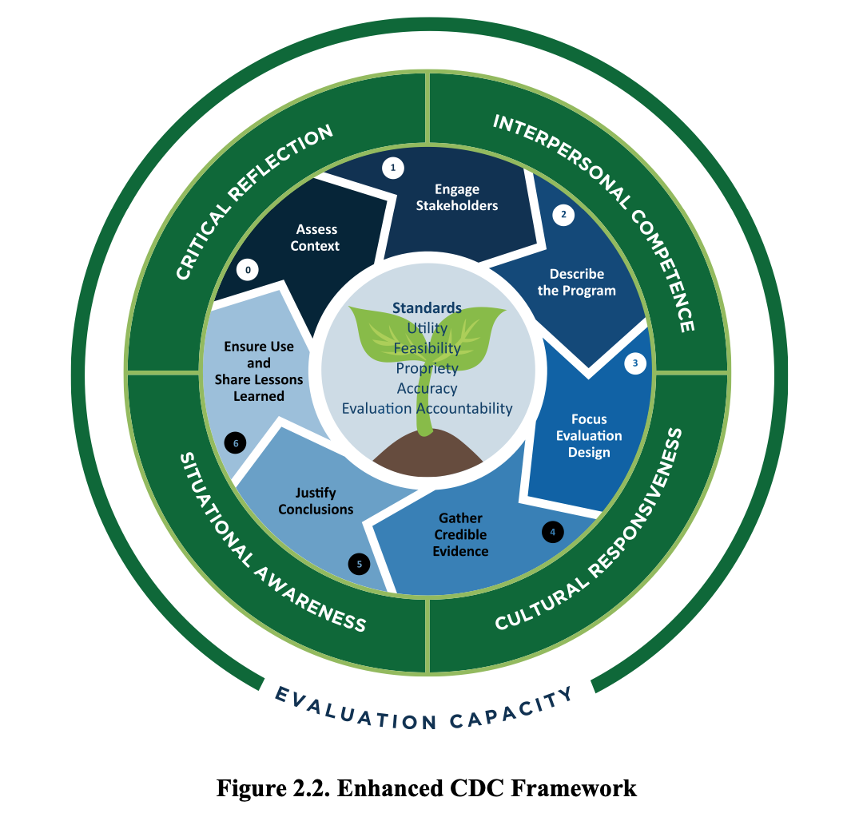Hello! We are Leslie Fierro, Heather Codd, and Ann Marie Castleman. Over the past several years we have engaged in scholarship and on-the-ground activities to help strengthen the capacity of individuals, teams, and organizations to plan, commission, and implement high-quality evaluations. One discipline that is heavily involved in evaluation is public health. Public health professionals are regularly called upon to engage in evaluation work, yet research studies (example 1, example 2, example 3) over the past decade demonstrate that the preparation public health professionals receive through traditional academic routes prepares them in some, but not all, ways to actively engage in the act following graduation.
Since the late 1990s, with their publication of a Framework for Program Evaluation in Public Health, the Centers for Disease Control and Prevention (CDC) has worked diligently to help strengthen the collective capacity of public health to engage in effective evaluation practice. A shining star within the CDC for strengthening evaluation capacity is the National Asthma Control Program (NACP). Since the early 2000s the NACP has implemented numerous evaluation capacity building (ECB) activities for/with their grantees, including but not limited to one-on-one technical assistance, peer-to-peer learning events, online and in-person trainings, and multiple written documents – both brief and long. In 2019, on CDC Evaluation Day, a team from NACP was awarded the CDC Exemplary Evaluation Award for their ECB efforts. As a result of these efforts, several free…and quite rad…resources are available to the broader evaluation community to strengthen evaluation capacity. We hope you will find them useful, we know we have!
Rad Resources
- Recently, the NACP updated their award-winning, six-module training series – Learning and Growing through Evaluation—to reflect recent developments in the field of evaluation.
- The NACP refined and slightly expanded the content in Learning and Growing through Evaluation to increase its applicability beyond their grantees to the broader public health community. This content is captured in a free, e-text – Planting the Seeds for High-Quality Program Evaluation in Public Health. The e-text includes, but is not limited to…
- An enhanced version of CDC’s Framework for Program Evaluation in Public Health, which includes…
- “Assessing context” prior to engaging in the original six steps,
- Four dimensions regarding the “how” of evaluation practice – interpersonal competence, critical reflection, situational awareness, and cultural responsiveness (tips for ways to integrate these into practice are included throughout the text),
- Evaluation capacity as a supporting force for an effective evaluation function.
- A summary of different evaluation theories, and examples for how they might be applied practically when planning evaluations.
- A chapter on strategic evaluation planning, detailed tips for evaluating specific topics (partnerships, surveillance, interventions), and an appendix with details on conducting economic evaluations.
- Several templates that can readily be adopted for your practice.
- Skill building exercises to hone your craft!
- An enhanced version of CDC’s Framework for Program Evaluation in Public Health, which includes…
- To complement these offerings, the NACP also created a document summarizing the templates available in the e-text as well as a brief that helps to answer the common question – How are performance measurement and evaluation similar and different?

The American Evaluation Association is hosting Organizational Learning and Evaluation Capacity Building (OL-ECB) Topical Interest Group Week. The contributions all this week to AEA365 come from our OL-ECB TIG members. Do you have questions, concerns, kudos, or content to extend this AEA365 contribution? Please add them in the comments section for this post on the AEA365 webpage so that we may enrich our community of practice. Would you like to submit an AEA365 Tip? Please send a note of interest to AEA365@eval.org. AEA365 is sponsored by the American Evaluation Association and provides a Tip-a-Day by and for evaluators. The views and opinions expressed on the AEA365 blog are solely those of the original authors and other contributors. These views and opinions do not necessarily represent those of the American Evaluation Association, and/or any/all contributors to this site.
